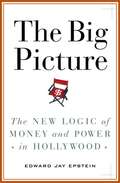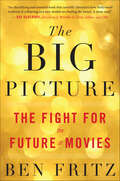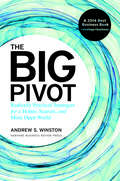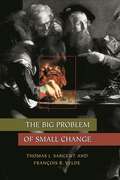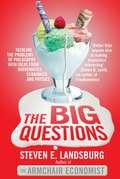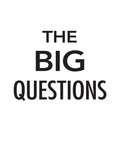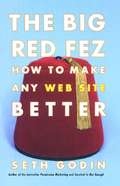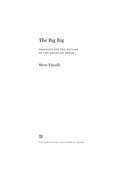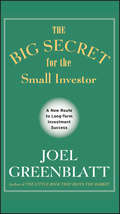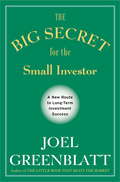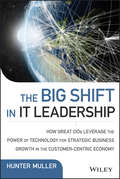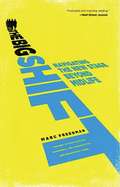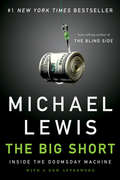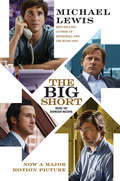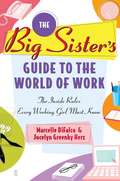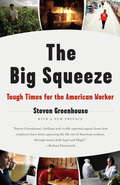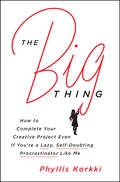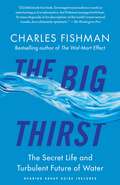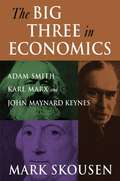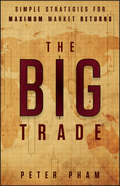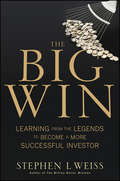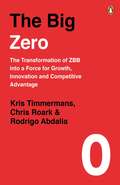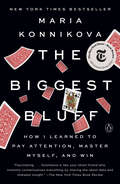- Table View
- List View
The Big Picture: Money and Power in Hollywood
by Edward Jay EpsteinIn this unprecedented, all-encompassing, and thoroughly entertaining account of the movie business, acclaimed writer Edward Jay Epstein reveals the real magic behind moviemaking: how the studios make their money. Epstein shows that in Hollywood, the only art that matters is the art of the deal: Major films turn huge profits not from the movies themselves but through myriad other enterprises, from video-game spin-offs and soundtracks to fast-food tie-ins, and even theme-park rides. The studios may compete for stars and Oscars, but their corporate parents view with one another in less glamorous markets such as cable, home video, and pay-TV. Money, though, is only a small part of the Hollywood story; the social and political milieus–power, prestige, and status–tell the rest. Alongside its remarkable financial revelations and incisive profiles of the pioneers who helped build Hollywood, The Big Picture is filled with eye-opening insider stories. If you are interested in Hollywood today and the complex and fascinating way it has evolved in order to survive, you haven’t seen the big picture until you’ve read The Big Picture.
The Big Picture: The Fight for the Future of Movies
by Ben FritzA Los Angeles Times Bestseller Winner of the Best Non-Fiction Book Prize at the 2018 National Arts & Entertainment Journalism Awards &“Ben Fritz crafts an electrifying and essential book that carefully chronicles how Hollywood tradition is collapsing and new models are fueling the future. A must-read.&”—Ava DuVernay, director of A Wrinkle in Time, Selma, and 13th The stunning metamorphosis of twenty-first-century Hollywood and what lies ahead for the art and commerce of film Ben Fritz chronicles the dramatic shakeup of America&’s film industry, bringing equal fluency to both the financial and entertainment aspects of Hollywood. He offers us an unprecedented look deep inside a Hollywood studio to explain why sophisticated movies for adults are an endangered species while franchises and super-heroes have come to dominate the cinematic landscape. And through interviews with dozens of key players at Disney, Marvel, Netflix, Amazon, Imax, and others, he reveals how the movie business is being reinvented. Despite the destruction of the studios&’ traditional playbook, Fritz argues that these seismic shifts signal the dawn of a new heyday for film. The Big Picture shows the first glimmers of this new golden age through the eyes of the creative mavericks who are defining what entertainment will look like in the new era.
The Big Pivot
by Andrew S. WinstonWe live in a fundamentally changed world. It's time for your approach to strategy to change, too.The evidence is all around us. Extreme weather, driven by climate change, is shattering records all over the planet. Our natural resources are in greater demand than ever before as a billion more people enter the global middle class, wanting more of everything. Radical transparency is opening up company operations and supply chains to public scrutiny.This is not some futuristic scenario or model to debate, but today's reality. We've passed an economic tipping point. A weakening of the foundations of our planetary infrastructure is costing businesses dearly and putting our society at risk. The mega challenges of climate change, scarcity, and radical transparency threaten our ability to run an expanding global economy and are profoundly changing "business as usual." But they also offer unprecedented opportunities: multi-trillion-dollar markets are in play, and the winners of this new game will profit mightily.According to Andrew Winston, bestselling author (Green to Gold) and globally recognized business strategist, the way companies currently operate will not allow them to keep up with the current-and future-rate of change. They need to make the Big Pivot.In this indispensable new book, Winston provides ten crucial strategies for leaders and companies ready to move boldly forward and win in this new reality. With concrete advice and tactics, and new stories from companies like British Telecom, Diageo, Dow, Ford, Nike, Unilever, Walmart, and many others, The Big Pivot will help you, and all of us, create more resilient businesses and a more prosperous world. This book is the blueprint to get you started.
The Big Pivot
by Andrew S. WinstonWe live in a fundamentally changed world. It's time for your approach to strategy to change, too.The evidence is all around us. Extreme weather, driven by climate change, is shattering records all over the planet. Our natural resources are in greater demand than ever before as a billion more people enter the global middle class, wanting more of everything. Radical transparency is opening up company operations and supply chains to public scrutiny.This is not some futuristic scenario or model to debate, but today's reality. We've passed an economic tipping point. A weakening of the foundations of our planetary infrastructure is costing businesses dearly and putting our society at risk. The mega challenges of climate change, scarcity, and radical transparency threaten our ability to run an expanding global economy and are profoundly changing "business as usual." But they also offer unprecedented opportunities: multi-trillion-dollar markets are in play, and the winners of this new game will profit mightily.According to Andrew Winston, bestselling author (Green to Gold) and globally recognized business strategist, the way companies currently operate will not allow them to keep up with the current-and future-rate of change. They need to make the Big Pivot.In this indispensable new book, Winston provides ten crucial strategies for leaders and companies ready to move boldly forward and win in this new reality. With concrete advice and tactics, and new stories from companies like British Telecom, Diageo, Dow, Ford, Nike, Unilever, Walmart, and many others, The Big Pivot will help you, and all of us, create more resilient businesses and a more prosperous world. This book is the blueprint to get you started.
The Big Pivot
by Andrew S. WinstonWe live in a fundamentally changed world. It's time for your approach to strategy to change, too.The evidence is all around us. Extreme weather, driven by climate change, is shattering records all over the planet. Our natural resources are in greater demand than ever before as a billion more people enter the global middle class, wanting more of everything. Radical transparency is opening up company operations and supply chains to public scrutiny.This is not some futuristic scenario or model to debate, but today's reality. We've passed an economic tipping point. A weakening of the foundations of our planetary infrastructure is costing businesses dearly and putting our society at risk. The mega challenges of climate change, scarcity, and radical transparency threaten our ability to run an expanding global economy and are profoundly changing "business as usual." But they also offer unprecedented opportunities: multi-trillion-dollar markets are in play, and the winners of this new game will profit mightily.According to Andrew Winston, bestselling author (Green to Gold) and globally recognized business strategist, the way companies currently operate will not allow them to keep up with the current-and future-rate of change. They need to make the Big Pivot.In this indispensable new book, Winston provides ten crucial strategies for leaders and companies ready to move boldly forward and win in this new reality. With concrete advice and tactics, and new stories from companies like British Telecom, Diageo, Dow, Ford, Nike, Unilever, Walmart, and many others, The Big Pivot will help you, and all of us, create more resilient businesses and a more prosperous world. This book is the blueprint to get you started.
The Big Problem of Small Change (The Princeton Economic History of the Western World #12)
by Thomas J. Sargent François R. VeldeThe Big Problem of Small Change offers the first credible and analytically sound explanation of how a problem that dogged monetary authorities for hundreds of years was finally solved. Two leading economists, Thomas Sargent and François Velde, examine the evolution of Western European economies through the lens of one of the classic problems of monetary history--the recurring scarcity and depreciation of small change. Through penetrating and clearly worded analysis, they tell the story of how monetary technologies, doctrines, and practices evolved from 1300 to 1850; of how the "standard formula" was devised to address an age-old dilemma without causing inflation. One big problem had long plagued commodity money (that is, money literally worth its weight in gold): governments were hard-pressed to provide a steady supply of small change because of its high costs of production. The ensuing shortages hampered trade and, paradoxically, resulted in inflation and depreciation of small change. After centuries of technological progress that limited counterfeiting, in the nineteenth century governments replaced the small change in use until then with fiat money (money not literally equal to the value claimed for it)--ensuring a secure flow of small change. But this was not all. By solving this problem, suggest Sargent and Velde, modern European states laid the intellectual and practical basis for the diverse forms of money that make the world go round today. This keenly argued, richly imaginative, and attractively illustrated study presents a comprehensive history and theory of small change. The authors skillfully convey the intuition that underlies their rigorous analysis. All those intrigued by monetary history will recognize this book for the standard that it is.
The Big Questions
by Steven E. LandsburgWhat's wrong with stealing? What's the best way to blood test a pot-bellied pig? Should we tolerate intolerance? In the wake of his enormously popular books, The Armchair Economist and More Sex is Safer Sex, Steven Landsburg uses concepts from maths, economics and physics to address the big questions in philosophy: Where does knowledge come from? What's the difference between right and wrong? Do our beliefs matter? Is it possible to know everything? Provocative, utterly entertaining and always surprising, The Big Questions challenges readers to re-evaluate their most fundamental beliefs and reveals the relationship between the loftiest philosophical quests and our everyday lives.
The Big Questions: Tackling the Problems of Philosophy with Ideas from Mathematics, Economics and Physics
by Steven E. LandsburgIn the wake of his enormously popular books The Armchair Economist and More Sex Is Safer Sex, Steven Landsburg uses concepts from mathematics, economics, and physics to address the big questions in philosophy: What is real? What can we know? What is the difference between right and wrong? And how should we live? Widely renowned for his lively explorations of economics, in his fourth book Landsburg branches out into mathematics and physics as well—disciplines that, like economics, the author loves for their beauty, their logical clarity, and their profound and indisputable truth—to take us on a provocative and utterly entertaining journey through the questions that have preoccupied philosophers through the ages. The author begins with the broadest possible categories—Reality and Unreality; Knowledge and Belief; Right and Wrong—and then focuses his exploration on specific concerns: from a mathematical analysis of the arguments for the existence of God; to the real meaning of the Heisenberg Uncertainty Principle and the Godel Incompleteness Theorem; to the moral choices we face in the marketplace and the voting booth. Stimulating, illuminating, and always surprising, The Big Questions challenges readers to re-evaluate their most fundamental beliefs and reveals the relationship between the loftiest philosophical quests and our everyday lives.
The Big Red Fez: How to Make Any Web Site Better
by Seth GodinYOUR WEB SITE IS COSTING YOU MONEY. IT'S ALSO FILLED WITH SIMPLE MISTAKES THAT TURN OFF VISITORS BEFORE THEY HAVE A CHANCE TO BECOME CUSTOMERS. According to marketing guru Seth Godin, a web site visitor is a lot like a monkey looking for one thing: a banana. If that banana isn't easy to see and easy to get, your visitor is gone with a quick click on the "Back" button. In this supremely practical, cut-to-the-chase book, Godin identifies what it takes to create web sites that satisfy visitors and keep them coming back for more. And he's at his prickly stickler best using real-life examples to illustrate the essential truths and ridiculous fictions about how a web site should work. Packed with his inimitable wisdom and compelling hands-on applications, The Big Red Fez is a must-have tool for anyone working on the web.
The Big Rig
by Steve ViscelliLong-haul trucks have been described as sweatshops on wheels. The typical long-haul trucker works the equivalent of two full-time jobs, often for little more than minimum wage. But it wasn't always this way. Trucking used to be one of the best working-class jobs in the United States. The Big Rig explains how this massive degradation in the quality of work has occurred, and how companies achieve a compliant and dedicated workforce despite it. Drawing on more than 100 in-depth interviews and years of extensive observation, including six months training and working as a long-haul trucker, Viscelli explains in detail how labor is recruited, trained, and used in the industry. He then shows how inexperienced workers are convinced to lease a truck and to work as independent contractors. He explains how deregulation and collective action by employers transformed trucking's labor markets--once dominated by the largest and most powerful union in US history--into an important example of the costs of contemporary labor markets for workers and the general public.
The Big Secret for the Small Investor
by Joel GreenblattAcclaim for Joel Greenblatt's New York Times bestseller "THE LITTLE BOOK THAT BEATS THE MARKET" "One of the best, clearest guides to value investing out there. " "--Wall Street Journal" "Simply perfect. One of the most important investment books of the last fifty years!" --Michael Price "A landmark book-a stunningly simple and low-risk way to significantly beat the market!" --Michael Steinhardt, the dean of Wall Street hedge-fund managers "The best book on the subject in years. " "--Financial Times" "The best thing about this book-from which I intend to steal liberally for the next edition of The Only Investment Guide You'll Ever Need-is that most people won't believe it. . . . That's good, because the more people who know about a good thing, the more expensive that thing ordinarily becomes. . . . " --Andrew Tobias, author of "The Only Investment Guide You'll Ever Need" "This book is the finest simple distillation of modern value investing principles ever written. It should be mandatory reading for all serious investors from the fourth grade on up. " --Professor Bruce Greenwald, director of the Heilbrunn Center for Graham and Dodd Investing, Columbia Business School
The Big Secret for the Small Investor: A New Route to Long-term Investment Success
by Joel GreenblattWhen it comes to investing in the stock market, investors have plenty of options: 1. They can do it themselves. Trillions of dollars are invested this way.(Of course, the only problem here is that most people have no idea how to analyze and choose individual stocks. Well, not really the only problem. Most investors have no idea how to construct a stock portfolio, most have no idea when to buy and sell, and most have no idea how much to invest in the first place.) 2. They can give it to professionals to invest. Trillions of dollars are invested this way. (Unfortunately most professionals actually underperform the market averages over time. In fact, it may be even harder to pick good professional managers than it is to pick good individual stocks.) 3. They can invest in traditional index funds. Trillions of dollars are also invested this way. (The problem is that investing this way is seriously flawed--and almost a guarantee of subpar investment returns over time.) 4. They can read The Big Secret for the Small Investor and do something else. Not much is invested this way. Yet... Let top hedge fund manager, Columbia business school professor, former Fortune 500 chairman and New York Times bestselling author, Joel Greenblatt, take you on a journey that will reveal the Big Secret for both individual and professional investors. Based on path-breaking new research, find out how anyone can beat the market, the index funds and the experts by following a new approach that relies on the principles of value investing, common sense and quantitative discipline. Along the way, learn where "value" comes from, how markets work, and what really happens on Wall Street. By journey's end, small investors (and even not-so-small investors) will have found their way to some excellent new investment choices.
The Big Shift in IT Leadership
by Hunter MullerLearn the unique leadership strategies of the effective, essential CIO Beyond the Cloud provides a blueprint for leadership in an era of high volatility, rapid transformation, and amazing growth. An effective CIO is essential to the successful navigation of turbulent and uncertain times, and this insightful guide gives you the actionable framework you need to execute the leadership strategies that work. Focused on the major factors that are critical to modern global enterprise, this book delves into communication, collaboration, relationships, technology, innovation, talent management, and more to provide well-rounded guidance toward principled leadership. Simple, straightforward language explains the basics of each area, and is expanded upon by real-world stories and revealing anecdotes gathered from the author's exclusive interviews with visionary thought leaders from major organizations worldwide. You get perspective from the top on established and emerging leadership strategies, helping you put these ideas to work right away. CIOs are perfectly positioned to provide the leadership required to stay ahead of the competition in complex, rapidly shifting markets. They break down walls, align resources, and facilitate collaboration to drive business value and spur growth amidst an atmosphere of hyper-competition. This guide is your practical handbook for becoming the leader that you need to be. Establish trust and cooperation across the enterprise Recruit and retain the top talent in your field Leverage new technology for continuous business growth Inspire loyalty and optimal performance from everyone on the team The CIO has never been more crucial to the enterprise than right now. With clear guidance toward the unique leadership skills the role requires, Beyond the Cloud is the foundational executive guide for transformational leaders in the new business era.
The Big Shift: Navigating the New Stage Beyond Midlife
by Marc FreedmanMarc Freedman, hailed by the New York Times as "the voice of aging baby boomers [seeking] meaningful and sustaining work later in life,” offers a recipe for how we can transform America’s coming midlife crisis into a midlife opportunity. Millions of people in their fifties, sixties, and seventies are searching for answers to the question "What’s next?” and are navigating their way to an entirely new stage of life and work, one that could last as long as midlife. Shifting to a much longer lifespan isn’t as easy as it may seem. Unlike the transition from adolescence to adulthood, managing this process for many is a do-it-yourself project. Drawing on powerful personal stories, The Big Shift provides not only direction but a vision of what it would take to help millions find their footing in a new map of life.
The Big Short: Inside the Doomsday Machine (Movie Tie-in Editions Ser.)
by Michael LewisThe real story of the crash began in bizarre feeder markets where the sun doesn't shine and the SEC doesn't dare, or bother, to tread: the bond and real estate derivative markets where geeks invent impenetrable securities to profit from the misery of lower- and middle-class Americans who can't pay their debts. The smart people who understood what was or might be happening were paralyzed by hope and fear; in any case, they weren't talking.<P><P> Michael Lewis creates a fresh, character-driven narrative brimming with indignation and dark humor, a fitting sequel to his #1 bestseller Liar's Poker. Out of a handful of unlikely-really unlikely-heroes, Lewis fashions a story as compelling and unusual as any of his earlier bestsellers, proving yet again that he is the finest and funniest chronicler of our time.
The Big Short: Inside the Doomsday Machine (movie tie-in) (Movie Tie-in Editions)
by Michael LewisThe #1 New York Times bestseller--Now a Major Motion Picture from Paramount Pictures From the author of The Blind Side and Moneyball, The Big Short tells the story of four outsiders in the world of high-finance who predict the credit and housing bubble collapse before anyone else. The film adaptation by Adam McKay (Anchorman I and II, The Other Guys) features Academy Award® winners Christian Bale, Brad Pitt, Melissa Leo and Marisa Tomei; Academy Award® nominees Steve Carell and Ryan Gosling. When the crash of the U.S. stock market became public knowledge in the fall of 2008, it was already old news. The real crash, the silent crash, had taken place over the previous year, in bizarre feeder markets where the sun doesn't shine and the SEC doesn't dare, or bother, to tread. Who understood the risk inherent in the assumption of ever-rising real estate prices, a risk compounded daily by the creation of those arcane, artificial securities loosely based on piles of doubtful mortgages? In this fitting sequel to Liar's Poker, Michael Lewis answers that question in a narrative brimming with indignation and dark humor.
The Big Sister's Guide to the World of Work
by Jocelyn Greenky Herz Marcelle Langan DifalcoEVERY WORKING WOMAN NEEDS A BIG SISTER In just one eight-hour day, a working woman can get more twisted up than panty hose in the spin cycle. The Big Sister's Guide to the World of Work will straighten her out. This tell-it-like-it-is handbook gives every working woman the tools for facing the forces of evil and opportunity in corporate America, including how to: Sidestep the classic mistakes women make in a new job Avoid getting tangled up in office politics Banish the seven habits that make you look small Get your boss on your side (without kissing up) Once entry-level know-nothings who rose to the top of the corporate ranks, DiFalco and Herz have been the go-to big sisters for hundreds of women who were mystified and mortified at the office. Now you can arm yourself with the authors' straight-shooting advice. Uninhibited and fiercely wise -- like the very best big sisters -- they are the mentors every working woman needs.
The Big Squeeze: Tough Times for the American Worker
by Steven GreenhouseWhy, in the world's most affluent nation, are so many corporations squeezing their employees dry? In this fresh, carefully researched book, New York Times reporter Steven Greenhouse explores the economic, political, and social trends that are transforming America's workplaces, including the decline of the social contract that created the world's largest middle class and guaranteed job security and good pensions. We meet all kinds of workers--white-collar and blue-collar, high-tech and low-tech, middle-class and low-income--as we see shocking examples of injustice, including employees who are locked in during a hurricane or fired after suffering debilitating, on-the-job injuries. With pragmatic recommendations on what government, business and labor should do to alleviate the economic crunch, The Big Squeeze is a balanced, consistently revealing look at a major American crisis.
The Big Thing: How to Complete Your Creative Project Even if You're a Lazy, Self-Doubting Procrastinator Like Me
by Phyllis KorkkiA New York Times business journalist explains why it’s important for people to pursue big creative projects, and identifies both the obstacles and the productive habits that emerge on the path to completion—including her own experience writing this book.Whether it’s the Great American Novel or a groundbreaking new app, many people want to create a Big Thing, but finding the motivation to get started, let alone complete the work, can be daunting. In The Big Thing, New York Times business writer and editor Phyllis Korkki combines real-life stories, science, and insights from her own experience to illuminate the factors that drive people to complete big creative projects—and the obstacles that threaten to derail success.In the course of creating her own Big Thing—this book—Korkki explores the individual and collaborative projects of others: from memoirs, art installations, and musical works to theater productions, small businesses, and charities. She identifies the main aspects of a Big Thing, including meaningful goals, focus and effort, the difficulties posed by the demands of everyday life, and the high risk of failure and disappointment. Korkki also breaks down components of the creative process and the characteristics that define it, and offers her thoughts on avoiding procrastination, staying motivated, scheduling a routine, and overcoming self-doubt and the restrictions of a day job. Filled with inspiring stories, practical advice, and a refreshing dose of honesty, The Big Thing doesn’t minimize the negative side of such pursuits—including the fact that big projects are hard to complete and raise difficult questions about one’s self-worth.Inspiring, wise, humorous, and good-natured, The Big Thing is a meditation on the importance of self-expression and purpose.
The Big Thirst: The Secret Life and Turbulent Future of Water
by Charles FishmanPraised as &“an entertaining and torrential flow of a book&” by Nature magazine, The Big Thirst is a startling examination of the passing of the golden age of water and the shocking facts about how water scarcity will soon be a major factor in our lives.The water coming out of your kitchen tap is four billion years old and might well have been sipped by a Tyrannosaurus rex. Rather than only three states of water—liquid, ice, and vapor—there is a fourth, &“molecular water,&” fused into rock 400 miles deep in the Earth, and that&’s where most of the planet&’s water is found. Unlike most precious resources, water cannot be used up; it can always be made clean enough again to drink—indeed, water can be made so clean that it&’s toxic. Water is the most vital substance in our lives but also more amazing and mysterious than we appreciate. As Charles Fishman brings vibrantly to life in this surprising and mind-changing narrative, water runs our world in a host of awe-inspiring ways, yet we take it completely for granted. But the era of easy water is over. Bringing readers on a lively and fascinating journey—from the wet moons of Saturn to the water-obsessed hotels of Las Vegas, where dolphins swim in the desert, and from a rice farm in the parched Australian outback to a high-tech IBM plant that makes an exotic breed of pure water found nowhere in nature—Fishman vividly shows that we&’ve already left behind a century-long golden age when water was thoughtlessly abundant, free, and safe and entered a new era of high-stakes water. In 2008, Atlanta came within ninety days of running entirely out of clean water. California is in a desperate battle to hold off a water catastrophe. And in the last five years Australia nearly ran out of water—and had to scramble to reinvent the country&’s entire water system. But as dramatic as the challenges are, the deeper truth Fishman reveals is that there is no good reason for us to be overtaken by a global water crisis. We have more than enough water. We just don&’t think about it, or use it, smartly. The Big Thirst brilliantly explores our strange and complex relationship to water. We delight in watching waves roll in from the ocean; we take great comfort from sliding into a hot bath; and we will pay a thousand times the price of tap water to drink our preferred brand of the bottled version. We love water—but at the moment, we don&’t appreciate it or respect it. Just as we&’ve begun to reimagine our relationship to food, a change that is driving the growth of the organic and local food movements, we must also rethink how we approach and use water. The good news is that we can. As Fishman shows, a host of advances are under way, from the simplicity of harvesting rainwater to the brilliant innovations devised by companies such as IBM, GE, and Royal Caribbean that are making impressive breakthroughs in water productivity. Knowing what to do is not the problem. Ultimately, the hardest part is changing our water consciousness. As Charles Fishman writes, &“Many civilizations have been crippled or destroyed by an inability to understand water or manage it. We have a huge advantage over the generations of people who have come before us, because we can understand water and we can use it smartly.&” The Big Thirst will forever change the way we think about water, about our essential relationship to it, and about the creativity we can bring to ensuring that we&’ll always have plenty of it.
The Big Three in Economics: Adam Smith, Karl Marx, and John Maynard Keynes
by Mark SkousenHistory comes alive in this fascinating story of opposing views that continue to play a fundamental role in today's politics and economics. "The Big Three in Economics" traces the turbulent lives and battle of ideas of the three most influential economists in world history: Adam Smith, representing laissez faire; Karl Marx, reflecting the radical socialist model; and John Maynard Keynes, symbolizing big government and the welfare state. Each view has had a significant influence on shaping the modern world, and the book traces the development of each philosophy through the eyes of its creator. In the twenty-first century, Adam Smith's "invisible hand" model has gained the upper hand, and capitalism appears to have won the battle of ideas over socialism and interventionism. But author Mark Skousen shows that, even in the era of globalization and privatization, Keynesian and Marxian ideas continue to play a significant role in economic policy.
The Big Trade
by Peter PhamA powerful, profitable, and elegantly simple system for tradersMarkets can be extraordinarily complex, and unfortunately most trading systems are too. The Big Trade presents a new system that helps filter out the noise. It leaves behind only meaningful signals you need to listen to in order to make profitable trades. Employing simple math and charts, it codifies the past behavior of traders in your favourite stock to assist you to recognize high probability trading patterns.Peter Pham's system breaks with traditional analytical tools and rejects the theory of predictability. Instead, it lets traders understand both how markets are structured and how they behave. The result is a simple action plan that is as effective and applicable for day traders as it is for generational investors. Blending his personal story and analytical techniques, The Big Trade guides traders of all experience level to find the probability that a stock price will rise or fall in a particular time period.The Big Trade:Gives traders a powerful, yet simple trading methodologyWas written by a trader with twelve years of both buy and sell side experience in global equities tradingIs appropriate for most styles of trading, including institutional investing and day tradingFor traders who want a universal approach that works for any market at any time, The Big Trade offers a new and effective methodology for successful trading without gimmicks or magic formulas.
The Big Win
by Stephen L. WeissA rousing and practical look at the extremely successful investments of top investors In his first book, The Billion Dollar Mistake, author Stephen L. Weiss showcased the biggest blunders of some of the world's legendary investors-which lost them billions of dollars on a single investment. Incredibly, the mistakes they made were the same mistakes made by everyday investors but for the magnitude of the loss. Weiss's second book, The Big Win: Learning from the Legends to Become a More Successful Investor, highlights financial successes, explaining how the world's most successful investors make a fortune and how you can do the same. As with the missteps Weiss profiled in his first book, the strategies used by these legendary investors are available to all, regardless of size or sophistication. Profiles legendary investors and highlights their investment strategies-from finding the right investment to researching to making a move Probes each investor's personality and questions their investment thinking Identifies and describes each investor's "big win" and why it became their most successful investment The Big Win is a primer on successful investing the way it is really done by the people who do it for a living-passionately and with extraordinary success. The Billion Dollar Mistake told readers what not to do to get rich; The Big Win shows readers how to do it right for the payoff of their lives.
The Big Zero: The Transformation of ZBB into a Force for Growth, Innovation and Competitive Advantage
by Kris Timmermans Chris Roark Rodrigo AbdallaDo you want to achieve startup speed at enterprise scale? Growth. It's what every company strives for. But it's become more and more elusive as companies struggle to hit their projected growth rates in an increasingly competitive market. While zero-based budgeting (ZBB) has been wielded for decades to cut costs, it falls short when it comes to spurring growth. But a zero-based mindset (ZBx) does that and more. ZBx facilitates forensic oversight into resource allocation that funnels savings back into growth initiatives and encourages new sources of innovation. The Big Zero shows how a ZBx approach focuses on agility over austerity, visibility over guesswork and the future over the past to fuel growth and competitiveness.
The Biggest Bluff: How I Learned to Pay Attention, Master Myself, and Win
by Maria KonnikovaHow a New York Times bestselling author and New Yorker contributor parlayed a strong grasp of the science of human decision-making and a woeful ignorance of cards into a life-changing run as a professional poker player, under the wing of a legend of the gameIt's true that Maria Konnikova had never actually played poker before and didn't even know the rules when she approached Erik Seidel, Poker Hall of Fame inductee and winner of tens of millions of dollars in earnings, and convinced him to be her mentor. But she knew her man: a famously thoughtful and broad-minded player, he was intrigued by her pitch that she wasn't interested in making money so much as learning about life. She had faced a stretch of personal bad luck, and her reflections on the role of chance had led her to a giant of game theory, who pointed her to poker as the ultimate master class in learning to distinguish between what can be controlled and what can't. And she certainly brought something to the table, including a Ph.D. in psychology and an acclaimed and growing body of work on human behavior and how to hack it. So Seidel was in, and soon she was down the rabbit hole with him, into the wild, fiercely competitive, overwhelmingly masculine world of high-stakes Texas Hold'em, their initial end point the following year's World Series of Poker.But then something extraordinary happened. Under Seidel's guidance, Konnikova did have many epiphanies about life that derived from her new pursuit, including how to better read, not just her opponents but far more importantly herself; how to identify what tilted her into an emotional state that got in the way of good decisions; and how to get to a place where she could accept luck for what it was, and what it wasn't. But she also began to win. And win. In a little over a year, she began making earnest money from tournaments, ultimately totaling hundreds of thousands of dollars. She won a major title, got a sponsor, and got used to being on television, and to headlines like "How one writer's book deal turned her into a professional poker player." She even learned to like Las Vegas.But in the end, Maria Konnikova is a writer and student of human behavior, and ultimately the point was to render her incredible journey into a container for its invaluable lessons. The biggest bluff of all, she learned, is that skill is enough. Bad cards will come our way, but keeping our focus on how we play them and not on the outcome will keep us moving through many a dark patch, until the luck once again breaks our way.
